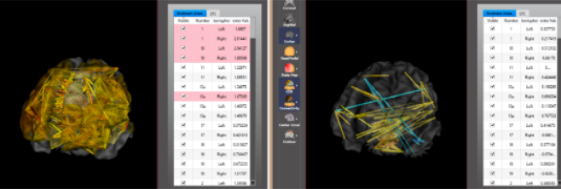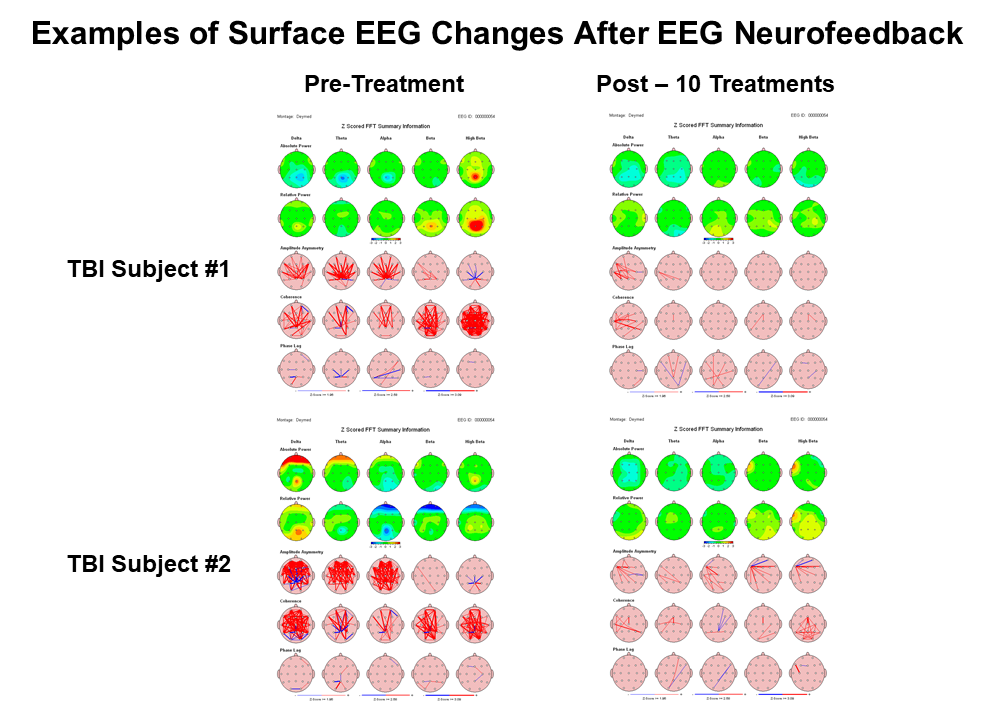Case Study Testimonials
What Our Clinicians Say about Using NeuroGuide™ and Neurofeedback…
Z Score Biofeedback has Transformed the Field of Neurofeedback
Dear All,
I just wanted to share some pretty amazing pre and post neurofeedback differences. The patient is a 23-year-old boy who was suffering from severe depression. When we first met, almost 3 months ago, he was too depressed to work.
At the time of writing, he’s had 46 sessions of neurofeedback, He’s now happily working 5 days a week. People who haven’t seen him for a while are commenting on how happy and engaged he seems. Everything else in his life is the same – no medication, nothing else to explain the changes except swLORETA neurofeedback.
Pre-Treatment Z Scored FFT, Theta and Alpha Current Source Density in the NeuroNavigator

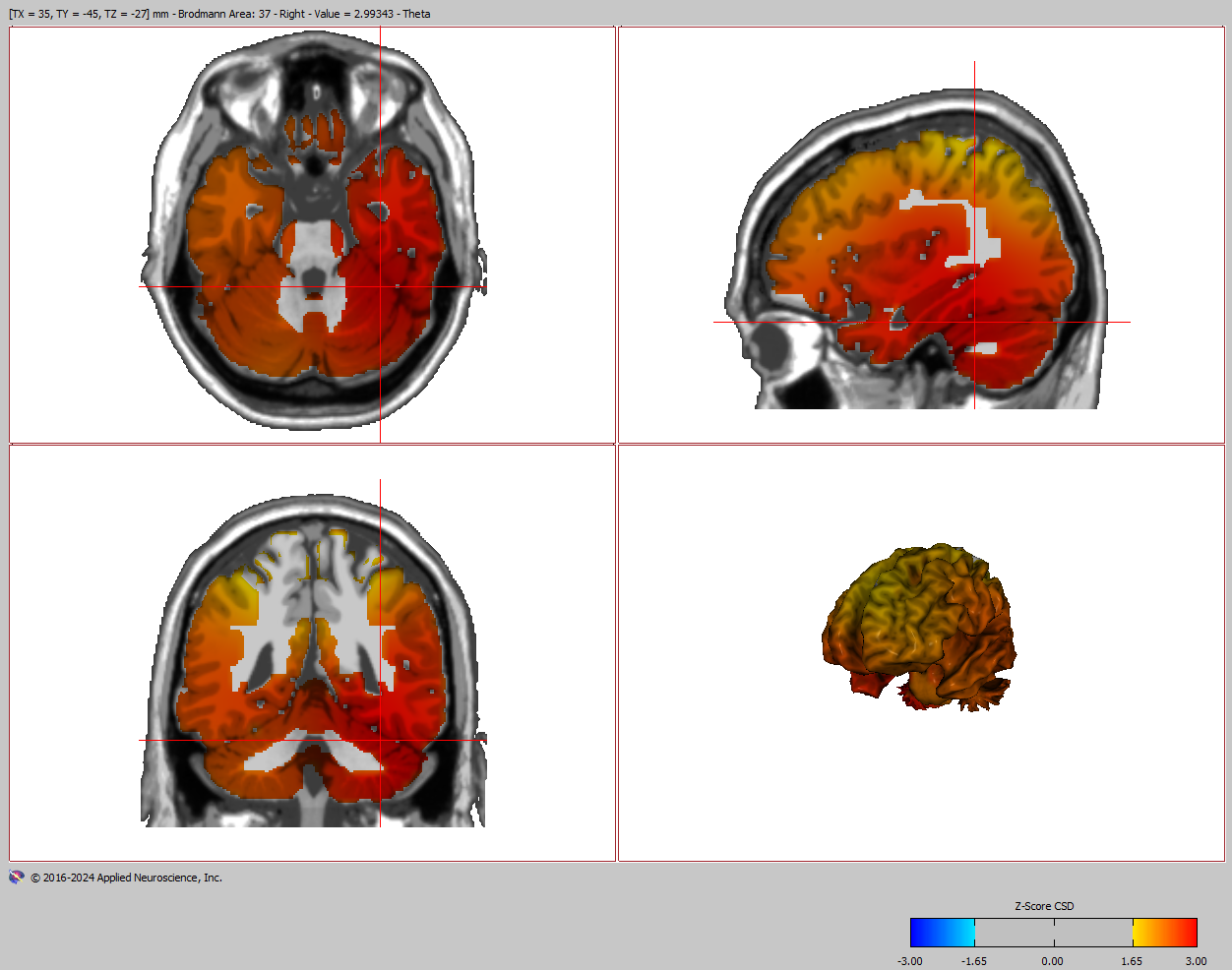

Z Scored FFT, Theta and Alpha Current Source Density After 46 Session of swLORETA Neurofeedback Treatment



Thank you, Bob, and everyone at ANI for making this possible.
Dear Colleagues,
We have been working with a client who was hospitalized with serious suicidal ideation prior to our beginning work with him. His parents reported that therapy and medication were not helping and they were very concerned about his level of depression and anxiety.
After 20 sessions, this client has made very significant progress!! I find this unusually fast given his level of symptoms when he started. We used swLoreta, and did customized protocols based on his symptoms of depression, anxiety, and obsessions.
His mother reported that he quit taking his medications after 4 weeks of treatment, His panic attacks have subsided and his anxiety and depressive symptoms have improved significantly. He is no longer suicidal and he is engaged in life!!
I wanted to bring this unusual case to your attention because I continue to be amazed at the power of neurofeedback. In particular, we are finding that swLoreta is giving us amazing results.
Below is an example of his baseline and 20 session follow-up maps for phase at 1-4 hz. I have also attached an image in case you can’t see them below.
Richard D. Abbey, Ph.D., BCN, QEEGD
Clinical Neuropsychologist
Clinical Psychologist
BCIA Board Certified in Neurofeedback
Board Certified in Quantitative EEG – Diplomate
Board Member QEEG Certification Board
Bob,
I was speaking to Rebecca and communicating with her how invaluable both BrainSurfer 2 and the swLORETA Cerebellum programs have become in my current practice. I work with a very select set of high functioning leaders, mostly high level CEOs, peak performers, entrepreneurial visionaries, advanced meditators etc.. – optimizing neuro functioning and increasing their capacity in everything from resilience, attention, speed of thought, emotional adaptation and integration, memory, insight, and reactivity. This direction was highly influenced by your paper back in 2013 on neuroleadership and our conversation on your boat here in San Diego. Being able to see the nodes and connections in BrainSurfer 2 has been a mainstay and proven invaluable in all the training throughout the years since its inception. The ability to select, connect, adjust and train areas in a number of different parameters such as power, coherence, phase and phase shift/lock has given me a way to really fine tune those unique variations and aspects of these gifted clients. The visualization of the nodes and connections for feedback influence the rate of learning and adaptions. This helps bring awareness to the feelings and locations we are working on with the client so they can be aware of these state changes in their day to day activities. This makes it so important to their daily lives.
The cerebellum training has brought about profound changes in emotional integration and resilience beyond what I have seen before. I am excited to see more intricacies of the training as I gain experience with the effects.
My hope for the future of these are for more elegant graphics for BrainSurfer 2 and the ability to change colors due to high amount of color blindness that I run into with my clients. For the Cerebellum, a fully animated Cerebellum representation would be wonderful with a variation of the graphically enhanced connections and current source density representations.
I wanted to extend a sincere thank you for bringing this into the world so that we can make it better place, one brain at a time.
Thank you,
Dr. Drew Pierson, L.Ac. DAOM
Carlsbad, California
NeuroGuide Z-Score training and the Symptom Checklist training have resulted in substantial improvement in patients. For example, a stroke victim who after just 3 full cap coherence sessions regained use of his arm and was able to close his hand as if holding a baseball or a chronically depressed woman who after just two full cap sessions claimed she felt like new person; and, another chronically anxious woman who stated she wanted as much of this stuff as she could get because she felt so good. Quite honestly, I have never seen this kind of rapid progress in certain patients with any other training format. My guess is you have taken neurofeedback training to a “new level.”
Robert McCarthy, Ph.D. McCarthy Counseling Associates, PA
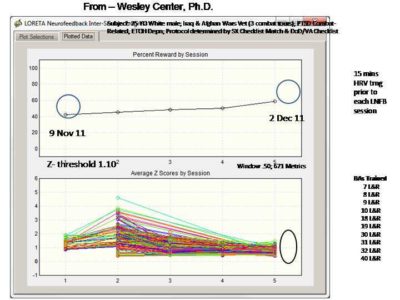 Attached is a summary of seven sessions of LNFB training with a young Marine combat veteran. Importantly, he is no longer taking any psychotropic medications and is going to start school next week. He told me today that he was feeling different but didn’t know what to attribute it to. I showed him the session progress screen and his eyes welled up and said, “I guess I am better.” I think he is too. Thanks for giving me the tools to help this youngster – as a retired Marine, being able to offer healing and hope to these kids is a big deal to me.
Attached is a summary of seven sessions of LNFB training with a young Marine combat veteran. Importantly, he is no longer taking any psychotropic medications and is going to start school next week. He told me today that he was feeling different but didn’t know what to attribute it to. I showed him the session progress screen and his eyes welled up and said, “I guess I am better.” I think he is too. Thanks for giving me the tools to help this youngster – as a retired Marine, being able to offer healing and hope to these kids is a big deal to me.
Wesley D. Center , Ph.D., LPC-S, NCC , BCPCC
I wanted to thank you for the opportunity to use Z score training. I have worked for ten years in neurofeedback and, while I have had good results, they do not compare to what I am getting now. Many of my patients report an immediate sense of calm when they are experiencing Z score training. It is as if the request that the brain communicate with itself better can be a much better challenge than asking the brain to improve at one or even two sites. My younger patients are often able to tolerate sitting still for the training because they feel immediately better and they want that feeling to continue. They complain of boredom much less often. Thanks again for your work. I feel Z score training is a big step toward helping to improve brains, one brain at a time.
Sincerely,
Kym Crown
I have put the surface Neurofeedback in use strait away and it seems to be an extremely valuable addition. I am also getting the first modest results with LORETA Z-scores from one of my clients who spent decades in therapy and was barely functional and is back to the Gym and full of new ideas and clarity that he professes not to have experienced for many years.
Dana Adams Ph.D.
Applied Neuroscience Team:
Here are examples of Pre vs Post Neurofeedback in two different patients with TBI after just 10 sessions. Here is the surface Z score differences:
Here is an example of current density Z scores in LORETA – pre vs post after 10 sessions:
 Bob and Applied Neuroscience:
Bob and Applied Neuroscience:
The parents of this young lady are pleased with a number of positive behaviors and overall attitude of their daughter. This is a progress map of a 12 year old girl with generalized anxiety who has a traumatic background. She started out having psychotherapy sessions for about 6 months and then began 19 Channel Surface Neurofeedback. Her clinical symptoms were: irritability, lack of focus and concentration, sadness, nightmares and anxiety.
After 8 sessions, Her parents report that she has improved her grades, is doing better with her homework, is less irritable, more sociable at home with family members, has a significant decrease in nightmares and appears to be handling stress (mostly school and peers) much better.
Many thanks again for helping me to help my clients.
Lea Leonard, LCSW, CTS, BCN – Naples, FL
Many thanks for all you have contributed to the field and especially to my clients.
Including the addition of your recommendations from the qEEG’s I send you, over 90% of my veterans of police service reach remission of their DSM-IV duty-related PTSD symptoms. They still require follow-up sessions including NF refresher which serves to pretty much eliminate any relapse and also help them get on with their lives. This is truly remarkable given the number, intensity, and duration of PTSD symptoms they come with, the large number of significant accumulated traumatic experiences they have had, the number of co-morbid conditions accompanying the PTSD, and how badly many have been treated by police management.
Hats off to you and personal regards
John Carmichael, Ph.D.
I Thought you might like to know last week did my first phase shift session with an autism spectrum teenager. Following week, last night, mother came in and said what did you do. Claimed her daughter was more conforming of requests and talked twice as much as ever before. I’ve worked with her for months, and while making progressing, have not seen this type of “step up” until now.
Very interesting and exciting.
Robert McCarthy, Ph.D.
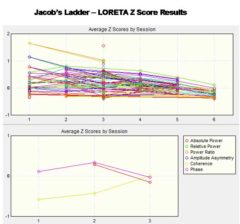 I am very excited about this: my 17 year old client has suffered from a lot of mental challenges. One that has lingered is amblyopia and a serious divergent strabismus. We tried developmental optometry for years: eye patching, eye exercises, etc., along with traditional NFB. But he continued to be monocular and one eye was shutting down which I verified by looking at his visal corrtex. Last year he had eye surgery and the surgeon said that he would never have binocular vision because it was “too late”. Although his eyes were ‘pulled together’ he was still only seeing with one eye post surgery. I did several sessions of LORETA and surface Z score training the past two months and last week he put 3D glasses on while looking at a 3D TV at best buy and he said “I can see 3D, I’ve never been able to before!” We verified this and this of course indicates that he is seeing binocular? He is shooting baskets in basketball like I have never seen too … this is amazing.
I am very excited about this: my 17 year old client has suffered from a lot of mental challenges. One that has lingered is amblyopia and a serious divergent strabismus. We tried developmental optometry for years: eye patching, eye exercises, etc., along with traditional NFB. But he continued to be monocular and one eye was shutting down which I verified by looking at his visal corrtex. Last year he had eye surgery and the surgeon said that he would never have binocular vision because it was “too late”. Although his eyes were ‘pulled together’ he was still only seeing with one eye post surgery. I did several sessions of LORETA and surface Z score training the past two months and last week he put 3D glasses on while looking at a 3D TV at best buy and he said “I can see 3D, I’ve never been able to before!” We verified this and this of course indicates that he is seeing binocular? He is shooting baskets in basketball like I have never seen too … this is amazing.
Thanks,
Wuttke, Executive Director Wuttke Insittute
Without your work all this would not be possible. Z-score NF is really great, it is helpful in so many cases – and I hear a lot of good reports from my workshop attendees. The approach isn´t too hard to understand and also its not too hard to teach to somebody. Good results can be made by everybody who really wants to learn. The fascinating thing is also when I feel that I also can be a part of this wonderful development.
Thomas Feiner, Ph.D.
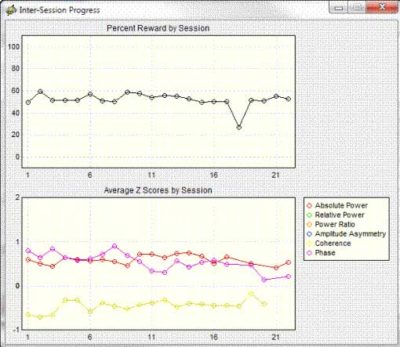 I have been using Neuroguide’s Z Score surface program for approximately 7 months and have been very impressed with the results. The following is a case of a 50 year old female who came to me in June of 2010 with major depressive DO even while medicated she had frequent bouts of crying, thoughts of suicide and days she could not get out of bed. She was under a great deal of stress, separated from her husband and had a very stressful job. Her medications were 225mg Effexor XR; 175mg of Wellbutrin and 1.5mg of Clonozepam. She began 19 Channel Surface Z Score Neurofeedback in August of 2011, she was in a much more stable place and able to cope with stressful situations. At the time of her first Neurofeedback session she had titrated down to 75mg of Wellbutrin and was going to continue to come off of that medication. Since then she has titrated down to 1mg of clonozepam and continues to take 225mg Effexor.
I have been using Neuroguide’s Z Score surface program for approximately 7 months and have been very impressed with the results. The following is a case of a 50 year old female who came to me in June of 2010 with major depressive DO even while medicated she had frequent bouts of crying, thoughts of suicide and days she could not get out of bed. She was under a great deal of stress, separated from her husband and had a very stressful job. Her medications were 225mg Effexor XR; 175mg of Wellbutrin and 1.5mg of Clonozepam. She began 19 Channel Surface Z Score Neurofeedback in August of 2011, she was in a much more stable place and able to cope with stressful situations. At the time of her first Neurofeedback session she had titrated down to 75mg of Wellbutrin and was going to continue to come off of that medication. Since then she has titrated down to 1mg of clonozepam and continues to take 225mg Effexor.
She has shown remarkable improvement in her mood and her ability to cope with stress. Today she feels that she does not need medication and will work with her Psychiatrist to titrate down the dosages of remaining Effexor and Clonozepam – her goal is to become medication free. She does understand that that may not be possible, however, she is willing to settle with much less medic ation if she needs to.
Her Neurofeedback protocol began with Absolute Power, Phase and Coherence working to bring 3+ Z scores to zero. She began to feel much calmer at 4 sessions. At 13 sessions she had cut clonozepam to 1mg from 1.5 and was completely off of Wellbutrin. She states that for the first time in 15 years she really feels her emotions, instead of a “numb or fog” feeling.
Along with her continued therapy and Neurofeedback sessions, she filled out the Walmyr self report tools: Generalized Contentment Scale and the Index of Clinical Stress. See below the continued improvement in both – she no longer meets criteria for either clinical condition.
My thanks and appreciation for all of your hard work to help me help my clients!!
Lea Leonard, LCSW, CTS, BCN
 This is a 25 year old female in her final year of law school. Her reported symptoms were anxiety, depression and attention deficits. Based on history and additional testing the latter seemed to be secondary to anxiety. She received 13 sessions of LORETA NF using the Symptom Checklist. She gradually reported lower anxiety/depression and better ability to focus and attend. She had been very worried about her ability to study for her final exams. She did very well in fact and is now articling with a quite prestigious law firm. I would likely have continued for a few more sessions but she is no longer living in Victoria . She will return for bi or tri weekly sessions if she feels she needs to.
This is a 25 year old female in her final year of law school. Her reported symptoms were anxiety, depression and attention deficits. Based on history and additional testing the latter seemed to be secondary to anxiety. She received 13 sessions of LORETA NF using the Symptom Checklist. She gradually reported lower anxiety/depression and better ability to focus and attend. She had been very worried about her ability to study for her final exams. She did very well in fact and is now articling with a quite prestigious law firm. I would likely have continued for a few more sessions but she is no longer living in Victoria . She will return for bi or tri weekly sessions if she feels she needs to.
Best,
Atholl Malcolm, Ph.D.
I am using Neuroguide Z-Score training more and more with patients. This is primarily due to the fact that Symptom Checklist Training suggestions have resulted in substantial clinical improvement with patients. For example, a stroke victim who after just 3 full cap coherence sessions regained use of his left arm and was able to close his hand as if holding a baseball (Continues to improve after 1 month); a chronically depressed woman who after just two full cap sessions claimed she felt like a new person (No longer lethargic, unmotivated); and, another chronically anxious woman who stated she wanted as much of this stuff as she could get because she felt so good (Going out, no longer hiding in house due to agoraphobia). I saw an extremely hyperactive boy this afternoon after just 2 full cap sessions using Symptom Checklist recommendations. His parents and all his teachers asked what medication he was taking as they never seem him so calm. Observably, the change was dramatic.
Quite honestly, I have never seen this kind of rapid progress in certain patients with any other system of training format. My guess is you have taken neurofeedback training to a “new level”.
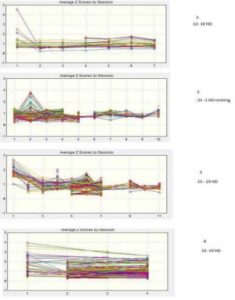 LORETA Neurofeedback and Neurofield.
LORETA Neurofeedback and Neurofield.
The attached pdf shows the clients change over several sessions. Each session began with Neurofield and followed with LORETA Z score neurofeedback. Each session was 1 hour.
The clients have been very pleased with their progress.
Phil Jones, Ph.D.
Dear ANI Team,
You should know that you make my job amazing and the lives of the clients I work with dramatically better! I go to work everyday and see things I never thought I would see. I sometimes have to pinch myself to see if I am awake, and ask myself, “how is this possible?” How am I lucky enough to live in such a time when we can change the human condition so dramatically. My colleague, former chief of psychiatry, often comments that “not much has significantly changed in psychiatry over the past 50 years”, and marvels at the changes we are able to make using Neuroguide and neurofeedback with his clients.
As a neuropsychologist, I have been extensively trained in identifying weaknesses. Back in my days of training, I had no idea that I would discover the wonderful world of neuroplasticity! Neuroguide is by far my best tool for neuroplasticity, and trust me, I have a lot of them. From the imaging to the neurofeedback, to very complex conditions to amazing outcomes and improvements that I did not know were possible. You are helping me change what is possible. I am in a very high tech area where there are several top tier medical facilities, one is just across the street from me. My clients often go there before they come to see me, coming to me with little to no solutions. Because of your amazing work and the tools you provide, I am able to facilitate significant change, leading to a different trajectory in the lives of my clients.
Thank you for all you do. I have visited your center and met many of you, and often think of you with great respect regarding the level of work that you are doing. You are truly an amazing team of scientists and clinicians that help me help others change their lives.
The funny thing is that I work all day and then I get to “play” at night, looking at the brain maps from the day and outcomes from the weeks of training.
Thank you for all you do!! I can’t wait to see what you come up with next!
Best,
Richard D. Abbey, Ph.D., BCN
Clinical Neuropsychologist
Clinical Psychologist
I am here in Cancun and have been doing demos for some important people here in Mexico and treating a select few folks here with NG LORETA – I want to give you some feedback regarding the observations that continue to mount. First, I believe that what you have done with the software, the symptom checklist, etc., in the right hands, is one of the biggest breakthroughs in behavioral medicine – really worth a Nobel prize – and I am not kidding. Over the past 3 days I have treated anorexia, Autism, seizure disorders, and clinical depression, all with noticable results within hours of the sessions – the depression client is astounded, “I feel I am alive again!” (this statement after one session). I believe your imperative, “Location! Location! Location!” is paramount as well as following a hierarchy of brain networks from foundation to higher cortical function. Anyway, I just wanted to say that I recognize this enormous accomplishment and contribution you have made and I am confident – more so with every person I treat – that ultimately this will be a major source of relief for so many – thanks for your good work.
The Wuttke Institute
Hi Bob,
This client is a 57 year man, with a history of anxiety and depression stemming from events in his developmental years. He is normally very successful in his occupation. On this occasion he over-extended himself with responsibility and this resulted in an acute reaction involving anxiety and depression (November 2010). There have been similar episodes in the past, but this is the first time I have seen him. On presentation in August he had been off work for two months and unable to get out of bed in the mornings. It should be noted that he has always had obsessive tendencies.
The first maps were obtained August 2011, and high power is evident, mainly from 11 to 25 Hz. (see attached). Coherence and phase were OK. The second maps were taken on November 23, 2011 after 16 sessions of LORETA NF . It can be seen that the extent of surface high power is significantly reduced. Other intermediate maps tracked the changes. At that point, it was decided not to continue with therapy even though there remained some hot areas because the client had been successfully back to work for a month and was reporting no discomfort due to anxiety or depression. Also, we discussed the fact his obsessive tendency was what motivated him at work and led to his success. Thus, we terminated with the understanding that it his option to return if symptoms re-emerge. In general we stuck to the adage of matching symptoms to location. So far, so good.
Best,
Atholl Malcolm, PH.D.
Pre-Treatment qEEG maps from August 11, 2011 – Symptoms are present
Below are Post Treatment qEEG maps November 23, 2011 – Symptoms improved and client was working and functioning well and decided to terminate treatment.

 Graph of Loreta Z score training for 18 year old with high anxiety associated with history of trauma– for the first time in quite a while she does NOT wake up feeling nauseous or anxious.
Graph of Loreta Z score training for 18 year old with high anxiety associated with history of trauma– for the first time in quite a while she does NOT wake up feeling nauseous or anxious.
Lea Leonard, LCSW, CTS, BCN
I have run a couple of sessions with BrainSurfer. Patients had 6 st. dev. LORETA Z scores before. They were able to normalize attention and addiction networks and Delta-Alpha power in less than 30 minutes…WOW! Thanks for the clue on rotating, and getting Brodmann areas. It is just fabulous to watch metrics normalize and be able to move to another network live.
Cheers, Grant Bright, Ph.D.
BOB, YOU AND YOUR TEAM ARE ABSOLUTELY AWESOME! I AM PROUD TO BE USING THIS INCREDIBLE SOFTWARE. IT’S HAVING A MAJOR IMPACT ON MY WORK WITH MY CLIENTELE. I HAVE BEEN ENCOURAGING MY COLLEAGUES TO GET ON THIS RIGHT AWAY!
KINDLY,
SAL BARBA
You will see the degree of attenuation of beta with no adverse reactions and clinically according to informants her level of functioning has improved as has mood stability and decreased reactivity. We still have a long way to go. This was done with straight LORETA and no other neuro modulation. She has significant Axis I, II and III difficulties complicating matters enormously. Shows you the power of LORETA.
Gerald Gluck,Ph.D., LMFT, PA
BCN, (Board Certified In Neurofeedback) Sr. Fellow
Very good. I have subjective improvement charted per session with qeeg data for each session. Of the first 100 I looked at I have 99% positive response (the one non-responder reported no subjective improvement but objective improvements were visible in his qEEG data). This is much better than I have gotten with pre-LORETA training.
I had an interesting testimonial yesterday from a client with a 42 year old brain injury and left hemiparesis: he looked at me with almost tears in his eyes and said, after 3 sessions “I was able to walk on the treadmill without holding onto the handrails for the first time in 42 years. I can plant my heel before my toes for the first time in 42 years. I can run for the first time in 42 years.” How’s that for specific, targeted training? I almost cried too.
Dale S Foster, PhD, QEEGT, BCN Sr Fellow
Thank you for ALL of these wonderful clinical tools. I have about 20 patients now, and 100% of them are benefiting significantly. You are helping many people in this world, and you have helped me change the lives of my clients in ways I didn’t know were possible!!!!
Thank you,
Richard D. Abbey, Ph.D.
Clinical Neuropsychologist
Clinical Psychologist
Abbey Neuropsychology Clinic
366 S. California Ave., Suite 9
Palo Alto, CA 94306
I have been using QEEG/ Neuroguide since 2010, and I get so much praise and support from attorneys. Attorneys say that my QEEGs are sometimes the only thing that gives them the edge over their competitors. Sometimes because of work pressure, or because a patient has an unsuitable hairstyle for QEEG, I have sent out neuropsychological reports without a Q. Several attorneys have sent the patients right back with messages such as “How can you do a report without a QEEG?”.
Dr. Joachim Fl. Mureriwa
I have been using the surface Z-score neurofeedback for a few months now and I just want you to say that I’m absolutely astonished about the results I get! I have been doing a lot of neurofeedback on childeren with autism in a clinical setting for the last 7 years and have never seen these kind of results before. Thank you very much for this great software!
Tim Smits
By the way, your program is having a big impact on the children and families in Palo Alto. A young man who recently came to me with symptoms of OCD has already experienced some symptom relief after only 10 sessions of Loreta neurofeedback! He is no longer afraid to fly on planes, is not afraid to stay away from home (stayed away for several days and has never had been away for even a single night before), and slept 12 hours for the first time in his life (usually sleeps half this amount at best). You are having a huge, positive impact on the world, and your program is allowing me and my team to do this one client at a time here in high tech Palo Alto. The computer engineers love it, because the automatically get the math (e.g., FFT), and it is a much better fit for most of them rather than medication.
All my best,
Richard D. Abbey, Ph.D., Clinical Neuropsychologist, Clinical Psychologist
Oh by the way – we love what you’ve done with Brainsurfer. The HMI is much more intuitive and in keeping with NF2. Being able to capture the session data is also a real benefit. Brilliant! And thanks!
Wesley D. Center, PhD, LPC-S, NCC, BCPCC, BCN
I see a large number of children and use your program, ages 4-15 and I have had solid and rapid success with most. One little girl went from having severe anxiety, throwing iPads at the wall and made dramatic changes in 10 sessions. Another, the son of a vet with PTSD had not gone to school for months because of severe anxiety and GI issues and while he took a little longer he has since graduated and 6 months later is still doing well, going to school. His father a gulf war vet, disabled with PTSD and severe sleep disorder is now doing LORETA.
Linda Marshall Kramer, MA
I cannot express to you how influential NeuroGuide and your contributions have been to my life. My son included.
Thanks.
Ken Olson, M.D.
NeuroGuide neurofeedback has produced the most amazing results in the shortest possible time. I must congratulate you on your fine product.
Hasan Asif, M.D.


Merlyn Hurd, Ph.D.
 RR had clinical symptoms related to a reported diagnosis of early stages of dementia. RR had trouble recalling words, was exceedingly forgetful, slow with speech. On 4/10/2015 I performed a QEEG and did LORETA Z Score neurofeedback. I utilized Neuroguide’s Symptom Checklist (SCL), matching symptoms to his QEEG, of executive function and working memory problems. RR participated in 6 more sessions utilizing Neuroguide’s SCL and NF Tools. The 8th session we returned to the original protocol based on the SCL of the 5/27/2015 QEEG. RR has shown significant improvement in executive functioning, memory retrieveal and organization skills as observed and self reported. This chart shows the Brodmann areas (BAs) or regions of interest that were targeted during neurofeedback. The top chart shows the percentage of rewards averaged for that particular session (number of times you could hear the sound and see the picture). The bottom chart shows the average Z score for each BA targeted. This particular graph shows areas as high as 3.8 std above the norm – by the 8th session all areas targeted fell to below 2 std deviations.
RR had clinical symptoms related to a reported diagnosis of early stages of dementia. RR had trouble recalling words, was exceedingly forgetful, slow with speech. On 4/10/2015 I performed a QEEG and did LORETA Z Score neurofeedback. I utilized Neuroguide’s Symptom Checklist (SCL), matching symptoms to his QEEG, of executive function and working memory problems. RR participated in 6 more sessions utilizing Neuroguide’s SCL and NF Tools. The 8th session we returned to the original protocol based on the SCL of the 5/27/2015 QEEG. RR has shown significant improvement in executive functioning, memory retrieveal and organization skills as observed and self reported. This chart shows the Brodmann areas (BAs) or regions of interest that were targeted during neurofeedback. The top chart shows the percentage of rewards averaged for that particular session (number of times you could hear the sound and see the picture). The bottom chart shows the average Z score for each BA targeted. This particular graph shows areas as high as 3.8 std above the norm – by the 8th session all areas targeted fell to below 2 std deviations.
Lea Leonard, LCSW, BCN
We have been doing 26 sessions of 19 channel Z-Score training ….. His progress is astounding!
Thanks for providing such great training tools.
Dr. med. Edith Schneider
I have great results with other people and love my job everyday! Thank you so much for that!
Jorien De Wandeler, The Netherlands
Thank you Bob!!
I am like a kid in a candy store with all the products you and ANI are putting out. As a neuropsychologist, I just can’t thank you enough. You are producing amazing ways to look at the brain and how it functions, and even more importantly, ways to provide therapies that matter!
Best,
Rick
It has been my pleasure to work with Dr. Thatcher & his crew at 3 addiction treatment centers.
Dr. Thatcher & Co. are indeed astute QEEG NFB and assorted other product-professionals and can help with constructing tailor-made programs to fit your patient population.
Best,
Dr. Karen Dodge, PhD, MSPH, LCSW
Executive Director of Neuro-Rehabilitative Services
Unity Behavioral Health
The LORETA neurofeedback program is fully integrated with multiple clinical interventions including individual and group therapy, psychiatric medication management where appropriate.This has decreased relapse which is a significant problem for the addiction disorder population. Many of the individuals who been treated are now employed and have returned to successful family life. There is no question that LORETA neurofeedback sometimes in conjunction with other techniques such as alpha stim is very powerful but is not a standalone treatment.
Joel Lubar, Ph.D.
Thank you for exposing us to unbelievable development in this field, adding to our knowledge and ability to contribute to mental health
Much appreciated.
Best regards
Annemie Peche, Ph.D.
Bob,
I can’t stand it!!! This is soooo exciting. I have been doing neurofeedback for 3 years now. As a neuropsychologist, I fall off my chair almost daily when I see the changes in our clients. The advancements you are making will help even more clients get better, and also will help the ones we are already helping get better to an even higher level.
I have some “impossible cases” in my clinic, and they are already getting better. One had a gun shot wound that went all the way through his prefrontal cortex, entering around F8 and exiting at F7. He wasn’t expected to survive, and now, after going through many sessions of neurofeedback, he is working and going to school.
Another child we have with Down Syndrome, has an IQ of 100, with a working memory of 120!! He is in the regular classroom with minimal use from a teacher’s aide.
I can hardly wait to get my hands on these new tools. When do you estimate they will be available?
Best,
Richard Abbey, Ph.D., Neuropsychologist
I’ve been seeing TBI clients that include more recent injuries as well as decades old, and I’m seeing great results with Loreta Z score NFB. It sure is fulfilling to help someone who has been struggling for so long, to see them clear up cognitively, improve functioning and their quality of life.
Daryl Lytle, LCMHC, BCN
Prior to NFB, a medical staff who sought treatment at our facility had network standard score of (± 4 ~ ± 6) > ± 2. Avery worse condition. He was very anxious, distracted, and experienced difficulty focusing. He was unable to work as a result. When we first saw the case, he had few words, slightly scrambled dialogue, and no facial expression. He used to be a very fine and craftman.
T2: After ten NFB sessions (T2), the case appeared to be more cheerful, he exhibited a greater number and diversity of facial expressions, and he was more energetic. The case felt that he was able to sleep more quickly, his thoughts were more positive, and his anxiety had improved. All networks had scaled down to have z-scores of (±2~±3). The case felt that his execution, memory, and emotional acuity needed to be strengthened. However, the case felt that he had achieved substantial progress and asked to stop training.
Simon Jung
I have taken a patient from an ACT score pre-neurofeedback of 17 to a post-neurofeedback score of 27 in 6 weeks with LORETA. He went to college for free and just graduated in neuroscience magna cum laude.
Thank you Bob and ANI for allowing me to see miracles.
Mike
Mike S. Pinkston, MA, LPC, QEEG-D
Clinical Director of Heart Matters, LLC
Dear Colleagues,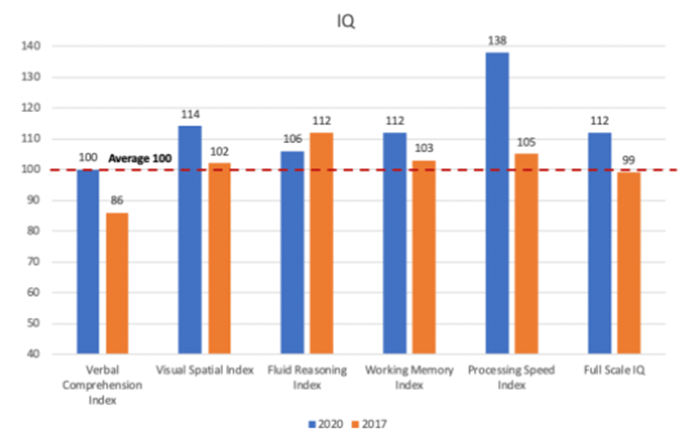
I was just reviewing the results from one of your clients, and I belted out, “OMG”!! Look at this, a substantial improvement in IQ!! I also attached it in Word in case you can’t see the image below. Holy Cow!! A full standard deviation in full scale, and 2 standard deviations in processing speed. Even her verbal IQ went up by a full standard deviation!!
Thank you Bob and the ANI Team, this is what it’s all about!!
Richard D. Abbey, Ph.D., BCN, QEEGD
Clinical Neuropsychologist
Clinical Psychologist
BCIA Board Certified in Neurofeedback
Board Certified in Quantitative EEG – Diplomate
Board Member QEEG Certification Board

